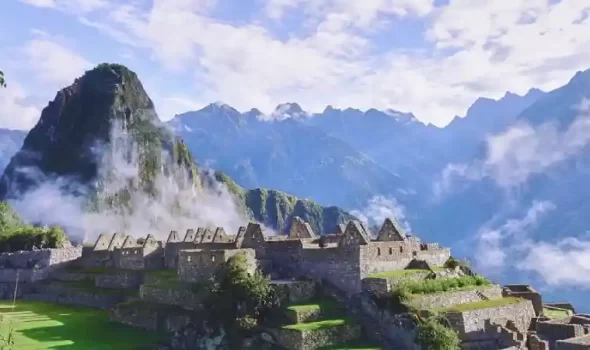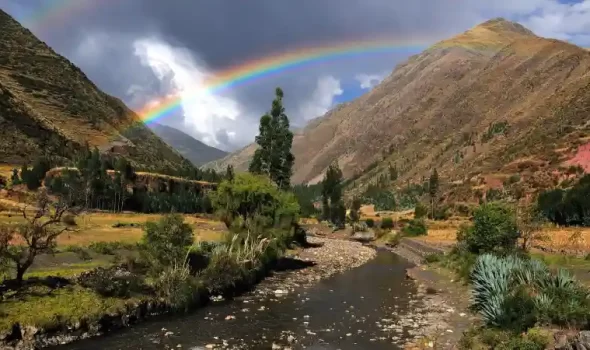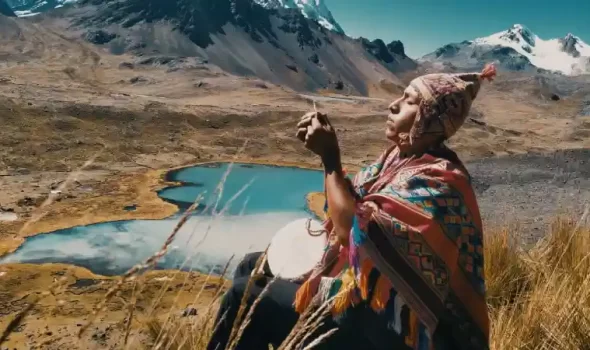There is more than one reason for you to be sure that Peru can be your ideal destination for 2024, however, there are still many people in the world who wonder. Where is Peru? As a tourist destination, Peru is proud of many factors such as food, natural spaces and of course having the world wonder of Machu Picchu. Auri Peru shows you that Peru is located where the dreams come true for your 2024 trip.
Join us to discover more about this magical destination, Peru is located where history remains alive and is considered one of the most incredible places in the world, where the geography of its 3 regions is well established (Coast, Andes and Jungle), the Traditions have been inherited for generations, tourist destinations of natural or historical origin are maintained and preserved to this day and the gastronomy is so delicious that it is recognized worldwide as one of the best. But first you will know the answer to where is Peru?
We recommend you see: Sacred Valley: A place where tradition and legacy outlast
WHERE IS PERU LOCATED?
To answer the question of Where is Peru? You should know that it is located on the western coast of South America, it currently borders the neighboring countries of Ecuador, Colombia, Brazil, Bolivia, Chile and naturally also with the Pacific Ocean. It has within its 03 geographical regions that are clearly marked and each one contains many ecosystems of natural life between plants and animals:

Where is Peru
- Coast region
The coastal region of Peru is a strip of land bathed by the waters of the Pacific Ocean, which extends for approximately 2,400 kilometers. Due to the area in which Peru is located, this region is home to rich marine biodiversity that supports an important fishing industry. Its beaches, some of the most beautiful in the world, attract surfers, sun worshipers and tourists in search of marine adventures. Additionally, the coastal region is known for its rich cultural history, evident in its impressive and enigmatic archaeological sites such as the Nazca Lines.

Peruvian Coast
Details about the climate: Its climate is mainly dry due to the presence of the Andes, these prevent the rainy winds that come from the Amazon from feeling strong and at the same time the air goes towards the external coast, producing little rain, which causes there to be little humidity. The temperature that we can find in this region regularly is between 19 °C in winter and 22 °C in summer. Despite the dryness, some parts of the Coast receive enough moisture from the winter fogs, which favors natural areas.
- Andean region
This region extends along the Andes mountain range, covering a large part of Peruvian territory and rising to impressive altitudes that exceed 6,000 meters above sea level in some points. This mountainous region is home to unique biodiversity, as well as a rich cultural history that is reflected in its indigenous peoples, ancient traditions and colorful festivities. The landscapes of the Peruvian mountains are simply spectacular, with snow-capped peaks, fertile valleys, crystal-clear lakes and deep canyons that captivate visitors. In addition, the Andes are known for being the cradle of the Inca civilization and home to important archaeological centers, but this is not known by everyone, which is why the frequent question that travelers ask are made is Where is Machu Picchu in Peru?, well now you know that it is located in the Andes region of Peru

Peruvian Andes
Details about the climate: The Andes contain many different climates that change depending on the context of height, elevation, winds and others. We must take into account the presence of 2 well-marked times such as the rainy season (November to April), during this time the temperature is normally 10°C to 15°C, during this time the presence of rain is much more frequent during the day. While in the dry season (May to October) the temperature is from 19°C to 25°C where the climate is more stable, there is not as much rain but we do have a large amount of wind.

Peru andean woman
- The jungle region
If you are looking to know where is Peru located? You will also be interested in knowing what you can find there. You will be able to see an extensive natural point that is the jungle region of Peru, also known as the Peruvian Amazon, it is a vast expanse of tropical humid forest that covers approximately 60% of the country’s territory. This exuberant region is one of the most biodiverse areas in the world and is home to an immense variety of flora and fauna, many of which are endemic species and still unknown to science. Its dense forests are home to a rich diversity of life, including jaguars, monkeys, parrots, anacondas and a wide range of birds and butterflies. The mighty rivers, such as the Amazon, the Ucayali and the Marañón, are the main arteries of transportation and sustenance for the indigenous and riverside communities that inhabit this region.

Peruvian Jungle
The Peruvian jungle is also rich in natural resources, including medicinal plants, precious woods and exotic fruits. In addition, it offers unique opportunities for adventure and ecotourism, with activities such as bird watching, canoe excursions along the rivers, and jungle walks guided by local experts. In the same way it also answers the question of Where is Machu Picchu in Peru? Because part of the sanctuary of the Inca citadel is within this region.

Where is Machu Picchu in Peru
Details about the climate: It is a warmer and more humid environment that completely characterizes the entire space that this region occupies. Here we can see that the presence of rain is much stronger and constant and it can last several days. The temperature here can reach up to 30° C during the day, but at night it can drop to 15° C.
LIMA PERU POPULATION
If you have ever wondered Where is Peru? Have you thought about how many people live in Peru? According to the last record of the INEI entity, until January 2024, a total of 34,574,490 inhabitants were registered throughout the country. The capital city of Lima is home to 30.2% of the total population and is one of the largest urban centers in Latin America. Its demographic diversity reflects internal migration from different cities, as well as the arrival of immigrants from various parts of the world. This cosmopolitan city is characterized by its bustling pace of life, its varied cultural offering, and its world-renowned gastronomic scene. Despite the challenges it faces in terms of infrastructure and social inequality, Lima remains the economic, political and cultural heart of Peru, attracting people from all backgrounds in search of unique opportunities and experiences.

Lima Peru
LANGUAGE
Peru is located where many cultures come together, for that reason there is a great variety of languages, however the official one in Peru is Spanish, a legacy of the colonial era that began in the 16th century. This language is spoken by the majority of the Peruvian population and is used in government, education, media and business. However, there are also other languages that stand out such as Quechua, spoken mainly in the Andes and parts of the jungle, and Aymara, which is found mainly in the southern region of the country. Additionally, there are numerous other indigenous languages spoken in specific communities, reflecting the rich cultural and linguistic diversity of Peru.

Peru culture
ABOUT MONEY IN PERU
The official currency of Peru is the Sol (PEN), the Sol has been the currency in circulation since 1991, replacing the old Inti. The bills come in denominations of 10, 20, 50, 100 and 200 soles, while the coins come in values of 1, 2 and 5 soles. The Sol is a stable and widely accepted currency throughout the country, and can be easily exchanged in banks and exchange offices. Learn more details about this in our article.
SOME UNIQUE THINGS ABOUT PERU
We know that you came here to know the answer to where is Peru located? but there is more than just that. There are some unique things about Peru that are truly incredible and we know you will love them:
- Alpacas are loved, about 86% of the entire world population can be found here.
- Creators of the Inca Kola soda, which stands out for its flavor.
- Real owners of Pisco, a grape-based liquor that is highly desired.
- It has the oldest university in America. The National University of San Marcos, located in Lima, was founded on May 12, 1551.
- It grows and has the largest number of types of potatoes.
Now you know the answer to where is Peru? and also where is Machu Picchu in Peru?, you can start your planning. Auri Peru will be more than happy to assist in planning this unforgettable adventure. Contact us now!
«I met a lot of people in Peru. I even found myself.”



















